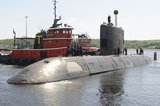KTA Naval Systems introduces ORCCA
KTA Naval Systems has introduced a new combat system for non-nuclear submarines at SubCon 2019.
KTA Naval Systems is a joint venture of Thyssenkrupp Marine Systems and Kongsberg.
The combat system, called ORCCA, combines adaptability with the highest level of IT security, enabling operators to conduct an integrated data analysis from a wide range of systems on board via one multifunctional console for a sound and quick decision-making process.
The modular design enables the integration of new technologies and adaptation to changing deployment scenarios throughout the lifetime of the system. Customers can constantly advance their combat system onboard to adapt to new requirements.
ORCCA will enable users to interact as part of a unit in multinational missions such as NATO or EU missions. The communication between the systems onboard and the national and international domain modules is separated by a special IT infrastructure.
Kathrin Rohloff, CEO of KTA Naval Systems, said: ‘ORCCA is the most modern combat system for non-nuclear submarines on the market. We brought together the expertise of our colleagues at Atlas Elektronik and Kongsberg Defense & Aerospace to create a unique combat system. We will equip all future submarines from Thyssenkrupp with this highly integrated system.’
The system can be used for all submarine classes of Thyssenkrupp Marine Systems, both as a retrofit or for new build boats.
More from Naval Warfare
-
![Maritime defence in the Mediterranean faces challenges from vulnerable land power]()
Maritime defence in the Mediterranean faces challenges from vulnerable land power
As an indispensable energy crossroads, the Mediterranean is at serious risk from grey zone disruption. As navies increasingly employ AI data centres, what happens when cutting-edge defence technologies rely on the very infrastructure most susceptible to hybrid tactics?
-
![US Navy to conduct an experimentation campaign with emerging tech in 2026 and 2027]()
US Navy to conduct an experimentation campaign with emerging tech in 2026 and 2027
The Technology Operational Experimentation Events will inform future requirements as the US Navy looks for innovative solutions across three key operational domains.
-
![Future Canadian Continental Defence Corvette will provide “Halifax-equivalent capabilities”]()
Future Canadian Continental Defence Corvette will provide “Halifax-equivalent capabilities”
Although the CDC project is still in its early stages, the Canadian Department of National Defence already has some requirements for the future platforms.
-
![US Navy to acquire micro-uncrewed underwater vehicles for ISR and coastal data collection]()
US Navy to acquire micro-uncrewed underwater vehicles for ISR and coastal data collection
The Naval Supply Systems Command is seeking authorised resellers of JaiaBot uncrewed underwater vehicles and multivehicle pods. The platforms will support undergraduate education at the US Naval Academy.






















